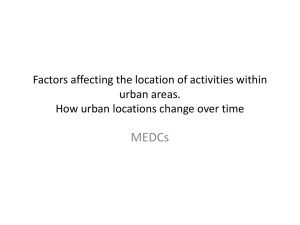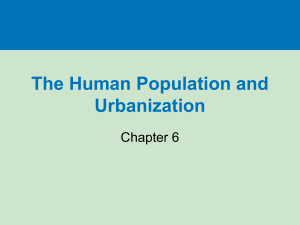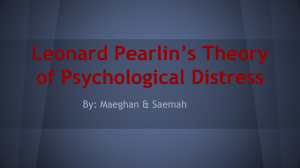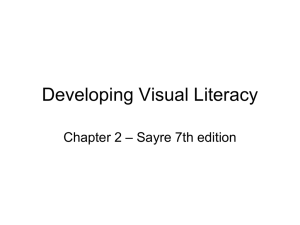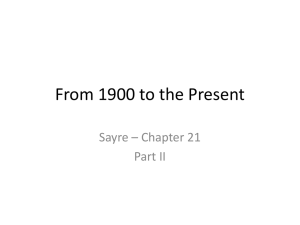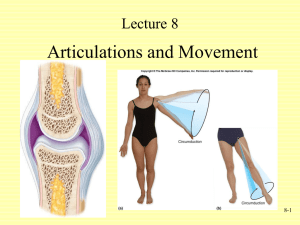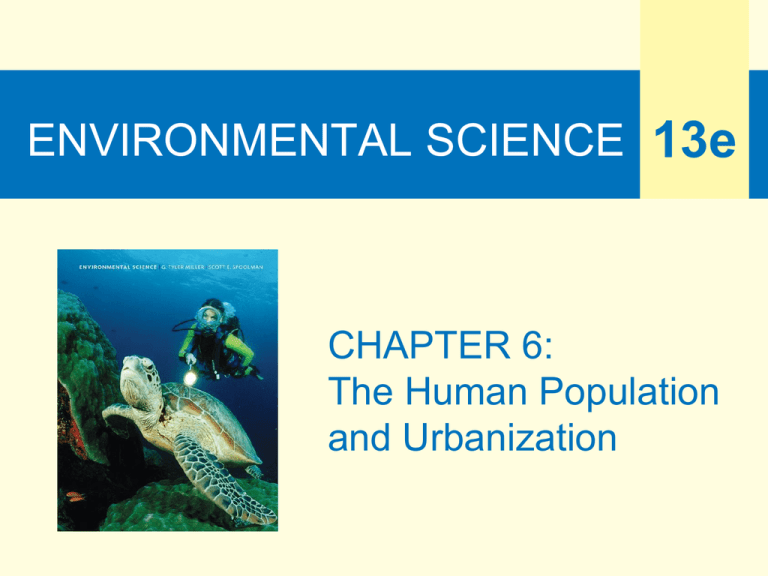
ENVIRONMENTAL SCIENCE 13e
CHAPTER 6:
The Human Population
and Urbanization
Global Population
• http://www.youtube.com/watch?v=sc4
HxPxNrZ0
Core Case Study: Are There
Too Many of Us? (1)
• 6.8 billion people
• 83 million more each year
• 2050: 9.5 billion people at current
growth rates
• Most growth in low-income and
middle-income countries
• Enough resources for growing
population?
A important question
• Can we provide an adequate
standard of living for a projected 2.7
billion more people by 2050 without
causing widespread environmental
damage?
• Overpopulation vs overconsumption
Core Case Study: Are There Too Many of
Us? (2)
• Negative viewpoint
– 20% currently lack basic necessities
– Declining conditions increase death rate
– Increased resource use
– Increased environmental degradation
• Positive viewpoint
– Technological solutions will increase carrying
capacity
– Growing population a valuable resource
Crowded street in China: largest population of all countries with 1.3 Billion people
Together China and India are home to 1 of every 3 people on Earth
Fig. 6-1, p. 94
6-1 How Many People Can the
Earth Support?
• Concept 6-1 We do not know how
long we can continue increasing the
earth’s carrying capacity for humans
without seriously degrading the lifesupport system that keeps us and
many other species alive.
Human Population Explosion
• Exponential growth (J-curve) in past
200 years
• Three major reasons
– Ability to expand into diverse habitats
– Emergence of agriculture
– Sanitation systems and control of infectious
diseases decreased death rates
How Long Can the Human
Population Grow?
•
•
•
•
Rate slowing, but still exponential
Uneven global growth
No population can grow indefinitely
2050: 9.5 billion people at current
growth rates
• Most growth in developing countries,
least likely to cope
13
Exponential Growth: the J-shaped curve of past world population growth
12
11
10
9
?
8
7
6
5
4
Industrial revolution
3
2
Black Death—the Plague
1
0
2-5 million 8000
years
Hunting
and gathering
6000
4000
2000
2000 2100
B.C. A.D.
Agricultural revolution Industrial
revolution
Fig.
1-1,
1
Fig.
1-10,p.
p. 16
12
UN world population projections
High
10.8
11
Population (billions)
10
Medium
9.5
9
8
7
Low
7.8
6
5
4
3
2
1950 1960 1970 1980 1990 2000 2010 2020 2030 2040 2050
Year
Fig. 6-2, p. 96
Natural Capital Degradation
Altering Nature to Meet Our Needs
Reduction of biodiversity
Increasing use of the earth's net primary productivity
Increasing genetic resistance of pest species and diseasecausing bacteria
Elimination of many natural predators
Introduction of potentially harmful species into communities
Using some renewable resources faster than they can be
replenished
Interfering with the earth's chemical cycling and energy flow
processes
Relying mostly on polluting and climate-changing fossil fuels
Fig. 6-3, p. 97
6-2 What Factors Influence the
Size of the Human Population?
• Concept 6-2A Population size increases
through births and immigration and
decreases through deaths and emigration.
• Concept 6-2B The average number of
children born to women in a population
(total fertility rate) is the key factor that
determines the population size.
Population Change
Population change =
(births + immigration) - (deaths + emigration)
Demographers look at birth rates and
death rates
• 2009:
China, 1.3 billion people
India, 1.1 billion people
USA, 306 million people
Number of Children
• Fertility rates affect population size
and growth rate
• Total fertility rate (TFR)
• 1950-2009: Global TFR fell to:
1.6 from 2.5 in developed countries
2.8 from 6.5 in developing countries
Case Study: The U.S.
Population Is Growing Rapidly
• Quadrupled in 100 years, despite
oscillations in TFR
• Baby boom: High TFR
• Current births outnumbering deaths
and legal immigration
• Growing faster than other developed
countries
• 2050 estimate: 439 million
TFR for US
4.0
Births per woman
3.5
3.0
2.5
2.1
2.0
1.5
1.0
Baby boom
(1946–64)
Replacement
level
0.5
0
1920 1930 1940 1950 1960 1970 1980 1990 2000 2010
Year
Fig. 6-4, p. 98
Factors Affecting Birth Rates (1)
• Importance of children as part of labor force
• Cost of raising and educating children
• Availability of retirement systems
• Urbanization
• Educational and employment opportunities for
women
Factors Affecting Birth Rates (2)
• Average marriage age
• Availability of legal abortion and
reliable birth control methods
• Religious beliefs, traditions, cultural
norms
Factors Affecting Death Rates
• Population growth is also response to
decline in crude death rate
• Life expectancy and infant
mortality rate important indicators of
overall health
• Average life expectancy increased
• Infant mortality – barometer of a
society’s quality of life
Supplement 3, Fig. 8, p. S10
*6-3 How Does a Population’s Age
Structure Affect Its Growth or Decline?
• Concept 6-3 The numbers of males
and females in young, middle, and
older age groups determine how fast
populations grow or decline.
*Age Structure
• Distribution of population
– Prereproductive
– Reproductive
– Postreproductive
• Country with many young people grows rapidly
• Country with many older people will decline
• Developing countries: >30% under 15 years old
Fig. 6-6, p. 102
Fig. 6-6, p. 102
Age Structure Predicts the Future
• 36% of U.S. population baby boomers
• Graying of America
• Over time: increasing percentage of
older baby boomers
• Changes the economy
Tracking the baby-boom generation in the United States. US population by
age and sex for years indicated.
1955
1985
2015
2035
Stepped Art
Fig. 6-8, p. 103
Declines Occur in Aging
Populations
• “Baby bust” or “birth dearth” – TFR
below 1.5 children per couple
• Labor shortages
• Strain on governments for public
services
• Fewer taxpayers
*6-4 How Can We Slow Human
Population Growth?
• Concept 6-4
We can slow population growth by
-reducing poverty
-encouraging family planning
-and elevating the status of women.
*Stages of Demographic Transition
•
•
•
•
Preindustrial
Transitional – demographic trap
Industrial
Postindustrial
• Some analysts believe that most of the world’s developing countries
will make a demographic transition over the next few decades,
mostly because modern technology can raise per capita incomes by
bringing economic development and family planning to such
countries. Other analysts fear rapid pop growth, extreme poverty,
and increasing environmental degradation in some low-income
countries could leave them stuck in stage 2.
Birth rate and death rate
(number per 1,000 per year)
Stage 1
Preindustrial
Stage 2
Transitional
Population
grows very
slowly because
of a high
birth rate
(to compensate
for high infant
80 mortality) and a
70 high death rate
Population grows rapidly
because birth rates are high and
death rates drop because of
improved food production and
health
Stage 3
Industrial
Stage 4
Postindustrial
Population growth
slows as both birth
and death rates
drop because of
improved food
production, health,
and education
Population growth
levels off and then
declines as birth
rates equal and
then fall below
death rates
Total population
60
Birth rate
50
40
30
Death rate
20
10
0
Low
Increasing
Very high
Decreasing
Growth rate over time
Low
Zero
Negative
Stepped Art
Fig. 6-10, p. 105
Think about it
• Stage 1: birth rate,
death rate, population
• Stage 3: birth rate,
death rate, population
• Stage 2: birth rate,
death rate, population
• Stage 4: birth rate,
death rate, population
Family Planning (1)
• Birth spacing, birth control, health
care
• Increased availability of contraception
• 55% drop in TFR of developing
countries
• Developing countries
– Almost half pregnancies unplanned
– Often lack access to family planning
Family Planning (2)
• Invest in family planning
• Reduce poverty
• Elevate the social and economic
status of women
Empowering Women Can Slow
Population Growth (1)
• Women tend to have fewer children if
they:
– are educated
– control their own fertility
– have a paying job outside the home
– do not have their rights suppressed
*Empowering Women Can Slow
Population Growth (2)
• Women do almost all domestic
housework and childcare
• Women do 60-80% of agriculture,
wood gathering, water hauling
• Globally, women do 2/3 of all work for
10% of income
Empowering Women Can Slow
Population Growth (3)
• Illiterate woman 64% of world’s
population, 70% of the poor
• When daughters considered less
valuable, not sent to school
• Poor conditions for women leads to
environmental degradation
Case Study: Slowing Population
Growth in China (1)
• One-child families
• Halved birth rate and drastically
reduce TFR
• Improved quality of life
• Strict family planning
• Sons still preferred – gender
imbalance
Case Study: Slowing Population
Growth in China (2)
• Population rapidly aging
• Rapidly growing economy
• Larger middle class increases
resource consumption and waste
• Sustainable economic plan needed to
avoid environmental degradation
Case Study: Slowing Population
Growth in India
• Tried to slow population growth for five
decades
• Most populous country in 2015
• Problems increase with growing
population
– Poverty
– Malnutrition
– Environmental degradation
– Growing middle class – resource consumption
Assignment
• Read Handout: “What do you think? Cultural Choices
and the Rate of Population Growth” that discusses the
approach to population control taken by two Indian
states, Kerala and Andra Pradesh
• Answer the question Which method of population control
(that used by Kerala or Andra Pradesh) offers better
insights and models for other countries? What are the
benefits and limitations of each approach?
• What do you think of the approach taken in Thailand?
Why might this approach not work everywhere?
6-5 What Are the Major Urban
Resource Environmental Problems?
• Concept 6-5 Most cities are
unsustainable because of high levels
of resource use, waste, pollution, and
poverty.
Urban Living
•
•
•
•
Half the world lives in urban areas
79% of Americans live in cities
50% of world population lives in cities
Urban areas continue to grow
– Natural increase
– Immigration
Major Trends in Urban Growth
• Proportion of urban global population
growing
• Number and sizes of urban areas
mushrooming
• Rapid increase in urban populations in
developing countries
• Urban growth slower in developed nations
• Poverty increasing
Shows populations of 18 megacities (each with 10 million or
more people) in 2009 and their projected populations in 2015. All but 3
are located in developing countries.
Karachi
10.4 million Dhaka
16.2 million 13.2 million Beijing
22.8 million
10.8 million
11.7 million
Los Angeles
13.3 million
19.0 million
Mexico City
18.3 million
20.4 million
New York
16.8 million
17.9 million
Sao Paulo
18.3 million
21.2 million
Key
2004 (estimated)
2015 (projected)
Buenos Aires
12.1 million
13.2 million
Cairo
10.5 million
11.5 million
Lagos
12.2 million
24.4 million
Mumbai
(Bombay)
16.5 million
22.6 million
Delhi
13.0 million
20.9 million
Calcutta
13.3 million
16.7 million
Jakarta
11.4 million
17.3 million
Tokyo
26.5 million
27.2 million
Osaka
11.0 million
11.0 million
Manila
10.1 million
11.5 million
Shanghai
12.8 million
13.6 million
Fig. 6-11, p. 108
Case Study: Urbanization in the
United States (1)
• 1800–2009: urban population
increased from 5% to 79%
• Migration patterns
– Rural areas to large cities
– Large cities to suburbs and smaller
cities
– Cities and suburbs to rural areas
– North and East to South and West
Almost 8 of every 10 Americans live in
urban areas. Areas with names in white
Are fastest growing metropolitan areas.
48% of all Americans live in cities of 1
million or more
Fig. 6-12, p. 109
Urban Sprawl is a product of
•
•
•
•
•
Prosperity
Ample and affordable land
Automobiles
Cheap gasoline
Poor urban planning
• Urban sprawl=growth of low density
development on the edges of cities and towns
Urban Sprawl Problems
• Increased automobile use
• Decreased energy efficiency
• Destruction of cropland, forests,
wetlands
• Economic deaths of some cities
Natural Capital Degradation
Urban Sprawl
Land and
Biodiversity
Loss of cropland
Loss of forests and
grasslands
Loss of wetlands
Loss and
fragmentation of
wildlife habitats
Water
Energy, Air,
and Climate
Increased use of surface
water and groundwater
Increased energy use
and waste
Increased runoff and
flooding
Increased air pollution
Increased surface water
and groundwater
pollution
Economic Effects
Decline of
downtown business
districts
Increased greenhouse
gas emissions
Increased
unemployment in
central city
Can enhance climate
change
Loss of tax base in
central city
Decreased natural
sewage treatment
Fig. 6-14, p. 110
Advantages of Urbanization (1)
•
•
•
•
•
Economic development
Innovation
Education and jobs
Technological advances
Longer life spans
Advantages of Urbanization (2)
•
•
•
•
Better social and medical services
Recycling more feasible
Biodiversity increased
Increased energy efficiency
Disadvantages of Urbanization (1)
•
•
•
•
Unsustainable systems
Lack of vegetation
Water problems
Pollution and health problems
Disadvantages of Urbanization (2)
•
•
•
•
Noise pollution
Climate and artificial light
Urban heat islands
Light pollution
Natural capital degradation: urban areas rarely are sustainable systems. Typical city
Depends on large non-urban areas for huge inputs of matter and energy resources
and for large outputs of waste matter and heat.
Inputs
Outputs
Energy
Solid wastes
Food
Waste heat
Water
Raw
materials
Manufactured
goods
Money
Information
Air pollutants
Water
pollutants
Greenhouse
gases
Manufactured
goods
Noise
Wealth
Ideas
Fig. 6-15, p. 111
Urban Poor in Developing Countries
• Slums
• Shantytowns and squatter
settlements
• Lack of basic services
Slums Mexico City
Case Study: Mexico City (1)
•
•
•
•
Large population
Severe noise, water, and air pollution
50% unemployment
100,000 premature deaths per year
Case Study: Mexico City (2)
•
•
•
•
3 million without sewer
Fecal snow
Geography contributes to air pollution
Progress – tree planting and lower air
pollution
6-6 How Does Transportation Affect
Urban Environmental Impacts?
• Concept 6-6 In some countries,
most people live in dispersed urban
areas and depend mostly on motor
vehicles for their transportation.
Cities Can Grow Outward or Upward
• Compact cities
– Transportation by walking, biking, or
mass transit
– Hong Kong, Tokyo
• Dispersed cities
– Transportation by automobile
– Most American cities
Automobiles
• Gas guzzlers
• 40,000 people per year die from auto
accidents in the United States
• World’s largest source of air pollution
• Lead to urban sprawl and congestion
Reduce Automobile Use
• User-pays system
• Full-cost pricing
• Tax revenues to finance mass transit,
bike paths, sidewalks
• High gasoline tax unlikely
• Need to discourage automobile use
Alternatives to Cars
•
•
•
•
Bicycles
Mass transit systems in urban areas
Bus systems
Rapid rail
Trade-Offs
Bicycles
Advantages
Disadvantages
Are quiet and
non-polluting
Provide little
protection in an
accident
Take few
resources to
make
Provide no protection
from bad weather
Burn no fossil
fuels
Are impractical for
long trips
Require little
parking space
Secure bike parking
not yet widespread
Fig. 6-18, p. 115
Trade-Offs
Mass Transit Rail
Advantages
Disadvantages
Uses less energy
and produces less
air pollution than
cars do
Is expensive to build
and maintain
Reduced need for
more roads and
parking areas
Is cost-effective only
in densely populated
areas
Causes fewer
injuries and
deaths than
cars do
Commits riders to
transportation
schedules
Reduces car
congestion in
cities
Can cause noise and
vibration for nearby
residents
Fig. 6-19, p. 116
Trade-Offs
Buses
Advantages
Disadvantages
Can greatly reduce car
use and air pollution
Can lose money because
they require affordable fares
Can be rerouted as
needed
Can get caught in traffic
and add to noise and
pollution
Cost less to develop
and maintain than
heavy-rail system
Commit riders to
transportation schedules
Fig. 6-20, p. 116
Trade-Offs
Rapid Rail
Advantages
Disadvantages
Is much more energy
efficient per rider than cars
and planes are
Is costly to run and
maintain
Produces less pollution
than do cars and planes
Causes noise and
vibration for nearby
residents
Can reduce need for more
air travel, cars, roads, and
parking areas
Has some risk of
collision at car
crossings
Fig. 6-21, p. 116
*6-7 How Can Cities Become More
Sustainable and Livable?
• Concept 6-7 An ecocity allows people
to choose walking, biking, or mass transit
for most transportation needs; recycle or
reuse most of their wastes; grow much of
their food; and protect biodiversity by
preserving surrounding land.
• What is an Ecocity? What is an
example of an ecocity?
Environmentally Sustainable Cities
• Smart growth
• Ecocities
– Use renewable energy as much as possible
– Build and design people-oriented cities
– Use energy and matter efficiently
– Prevent pollution and reduce waste
– Recycle, reuse, and compost
– Protect and encourage biodiversity
– Promote urban gardens and farmers markets
– Zone for environmentally stable population
levels
Homework Assignment
• Go on an ecocity scavenger hunt! Find at
least 3 things in Athens or on campus that
could be found in an ecocity.
• Take pictures and email them with a
description of why you think you would find
it in an ecocity
• You may work in pairs or groups of 3 if you
wish
Solutions
Smart Growth Tools
Limits and Regulations
Protection
Limit building permits
Urban growth
boundaries
Greenbelts around cities
Preserve existing open space
Public review of new
development
Buy new open space
Buy development rights that
prohibit certain types of
development on land parcels
Taxes
Zoning
Encourage mixed use of
housing and small
businesses
Concentrate
development along mass
transportation routes
Promote high-density
cluster housing
developments
Planning
Ecological land-use
planning
Environmental impact
analysis
Integrated regional
planning
State and national
planning
Tax land, not buildings
Tax land on value of actual use
(such as forest and agriculture)
instead of on highest value as
developed land
Tax Breaks
For owners agreeing not to
allow certain types of
development (conservation
easements)
For cleaning up and
developing abandoned
urban sites (brownfields)
Revitalization and New Growth
Revitalize existing towns and
cities
Build well-planned new towns
and villages within cities
Fig. 6-22, p. 117
*Case Study:
Curitiba, Ecocity in Brazil (1)
• Curitiba – “ecological capital” of Brazil
• Inexpensive, efficient mass transit
• High-rise apartments near bus routes,
mixed-use structures
• Bike and pedestrian paths
Case Study: Curitiba, Ecocity in
Brazil (2)
•
•
•
•
1.5 million trees planted
Recycling
Many services for the poor
Emphasis on ecological awareness,
health, literacy
Curitiba Video
• http://www.youtube.com/watch?v=hR
D3l3rlMpo&feature=fvw
Bus rapid transit system in Curitiba, Brazil. Boarding is speeded up by the use of
Extra-wide doors and boarding platforms sheltered by large glass tubes where
passengers can pay before getting on the bus.
Fig. 6-23, p. 118
Each of the 5 major spokes has 2 express lanes used only
by buses.
City
center
Route
Express
Interdistrict
Direct
Feeder
Workers
Fig. 6-23, p. 118
Three Big Ideas from This
Chapter - #1
The human population is increasing
rapidly and may soon bump up
against environmental limits.
Three Big Ideas from This
Chapter - #2
We can slow human population growth
by reducing poverty, encouraging
family planning, and elevating the
status of women.
Three Big Ideas from This
Chapter - #3
Most urban areas, home to half of the
world’s people, are unsustainable, but
they can be made more sustainable
and livable within your lifetime.
Review Growth Curves
Exponential Growth
Logistic Growth
Carrying capacity= capacity of a given habitat to support a given species,
stated in terms of the maximum population of the species that the habitat
can support over a given period
*What will happen to the population size in the
future in each of the age structure diagrams?
*What will happen here?
Fig. 6-6, p. 102


